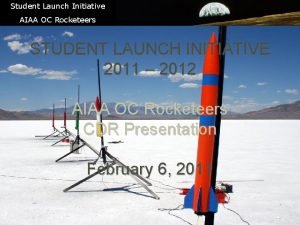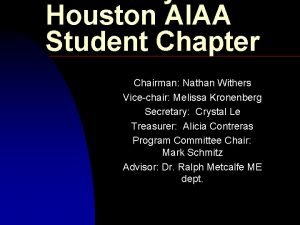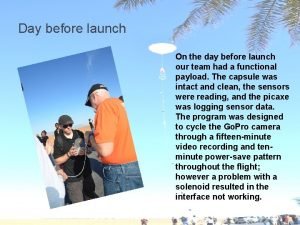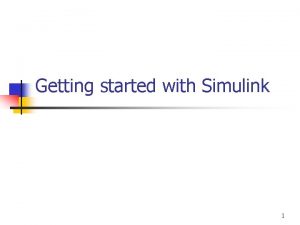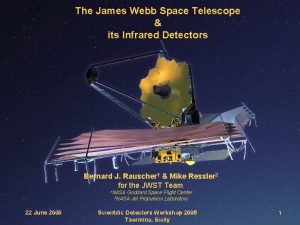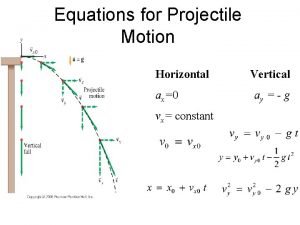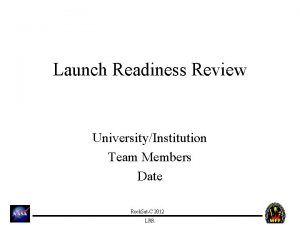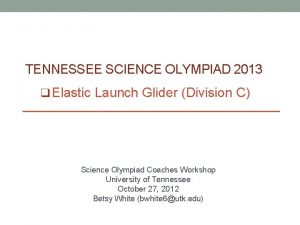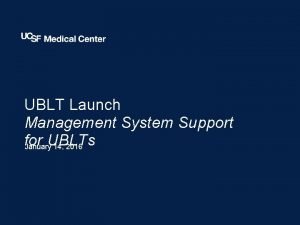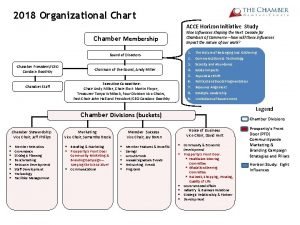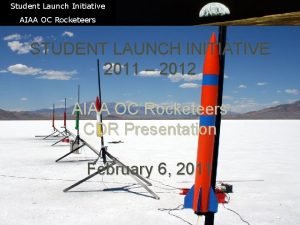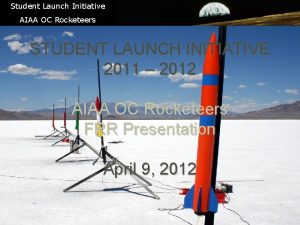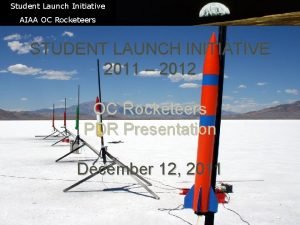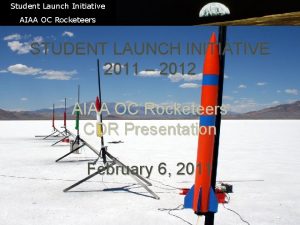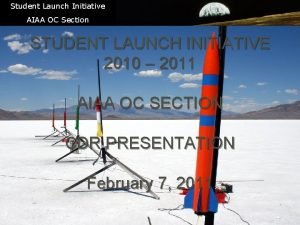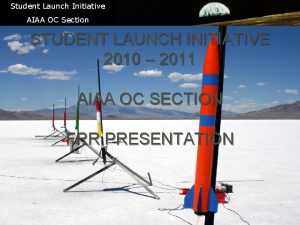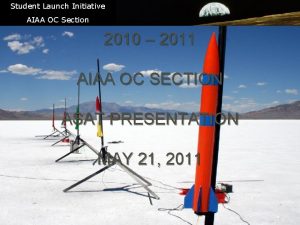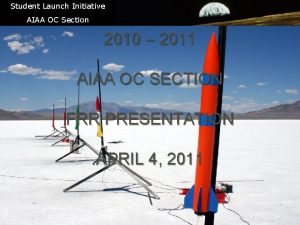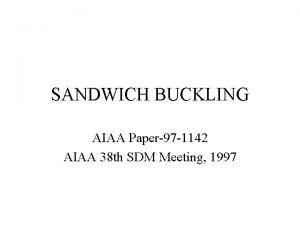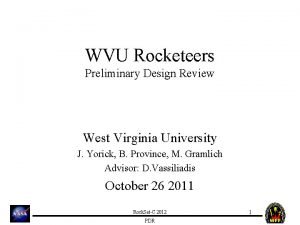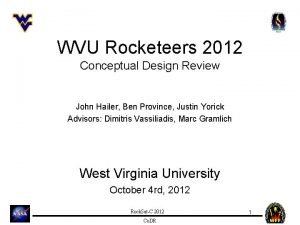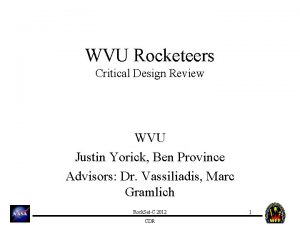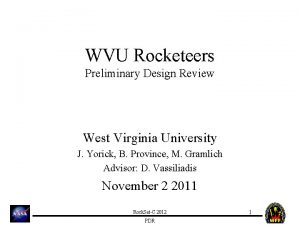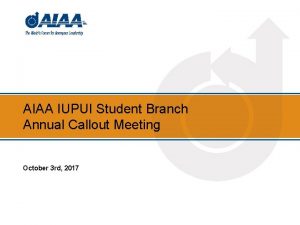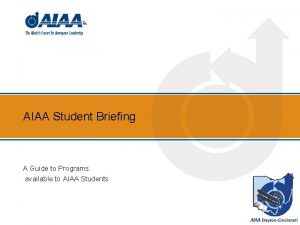Student Launch Initiative AIAA OC Rocketeers STUDENT LAUNCH





















































- Slides: 53

Student Launch Initiative AIAA OC Rocketeers STUDENT LAUNCH INITIATIVE 2011 – 2012 AIAA OC Rocketeers FRR Presentation April 9, 2012 1

Student Launch Initiative AIAA OC Rocketeers Agenda u u u u Introduction of team members (representing 4 high schools in Orange County California) Scale model testing and results Full Scale Design • Vehicle • UAV Payload – Description, Safety, and Testing • Recovery System and Events • GPS • Integration Feedback form checklist Risks and Safety Educational Outreach Budget and Timeline Corrected 3 slides, added scale launches 2&3 & RC plane testing 2

Student Launch Initiative AIAA OC Rocketeers Full Scale Design 3

Student Launch Initiative AIAA OC Rocketeers Vehicle – Full Scale Parameter Details Length/Diameter 125 inches / 5 inches Material . 075” thick filament wound Carbon Fiber from Performance Rocketry Shock Cord 1” Tubular Nylon Center of Pressure/Center of Gravity 94”/78. 3”behind nose tip Stability Margin 3. 14 Launch System / Exit Velocity 1” 8 ft Rail / 80. 4 ft/s 4

Student Launch Initiative AIAA OC Rocketeers Vehicle – Full Scale cont’d Parameter Details Liftoff Weight 20. 8 lbs Descent Weight 17. 8 lbs Preferred Motor Aerotech K 1050 Thrust to weight ratio 11. 35 (1050 Newtons average thrust = 236 N / 20. 8 lb vehicle) Maximum ascent velocity 748. 62 ft/s Maximum acceleration 445. 61 ft/s/s Peak Altitude 5244 ft Drogue – Descent rate 77. 75 ft/s Lower section under Main – Descent rate (Kinetic energy at ground level) 17. 4 ft/s (48 ftlb-force) Upper section under its own chute – descent rate (Kinetic energy at ground level) 17. 2 ft/s (24. 4 ftlb-force) UAV on its own parachute – descent rate (Kinetic energy at ground level if UAV is not released) 18. 5 ft/s (5. 33 ftlb-force) 5

Student Launch Initiative AIAA OC Rocketeers Vehicle – Forward Section Parameter Details Nose Cone Carbon Fiber 24” long Body Tube . 075” thick Carbon fiber 5” diameter x 56” long Bulkhead ½” plywood with fiberglass on both faces with “U” bolt for shock cord attachment Shock Cord 1” Tubular Nylon x 20 ft + 4 ft (Piston) Sabot Carbon Fiber coupler, split lengthwise, hinged Forward Cavity 10” x 5” diameter for ejection charge, shock cord, GPS, and forward section parachute (56” – 5” for avionics bay – 5” for nose cone – 31” for sabot – 5” for piston) Ejection Charge 1. 8 grams (250 lbs) 6

Student Launch Initiative AIAA OC Rocketeers Vehicle – Avionics Bay Parameter Details Bay Material Carbon Fiber tubing 12” long – coupler for 5” body tube Body Tube . 075” thick Carbon fiber 5” diameter x 1” long Bulkhead ½” plywood with fiberglass on both faces with closed eye bolt for shock cord attachment Sled 1/8” plywood with ¼” threaded rods the entire length Electronics HCX and Raven flight computers, Batteries Terminal Blocks (for ejection chg) Aft: Drogue primary and backup, Main primary and backup Forward: UAV deploy primary and backup 7

Student Launch Initiative AIAA OC Rocketeers Vehicle – Rear Section Parameter Details Body Tube . 075” thick Carbon fiber 5” diameter x 38. 75” long Centering Rings 2 ply x 3/32” = 3/16” fiberglass with “U” bolt for shock cord Shock Cord 1” Tubular Nylon x 15 ft + 6 ft (across Tender Descender) Rear Cavity 12. 75” x 5” diameter for ejection charge, shock cord, GPS, and forward section parachute (38. 75 + 3” for tailcone + 4” inside avionics bay – 6” for avionics bay overlap - 27” for motor) Ejection Charge 3. 25 grams (250 lbs) Tender Descender . 2 grams (per the data sheet) 8

Student Launch Initiative AIAA OC Rocketeers Aerotech K 1050 (Alternate: Cesaroni K 600) Designation K-1050 W-SU Total Weight 2128 grams Manufacturer Aerotech Propellant Weight 1362 grams Motor Type Single Use Average Thrust 1050. 0 N Diameter 54. 0 mm Maximum Thrust 2164. 0 N Length 67. 6 cm Total Impulse 2530. 0 Ns Propellant White Lightning Burn Time 2. 3 s Cert Organization TRA Isp 189 s 9

Student Launch Initiative AIAA OC Rocketeers Launch Simulations • Simulations were run using Rocksim • Over 100 simulations were run to fine tune vehicle • Dimensions, weights, and launch conditions were varied • Once vehicle was designed varied engines to attain 1 mile altitude • Verified top speed was still subsonic • Verified range with varied winds 10

Student Launch Initiative AIAA OC Rocketeers Vehicle Construction The vehicle is made of composite materials • Body tube is 5” diameter. 075” thick filament wound carbon fiber • The nose cone is the same material • Sabot is thinner couple but of the same material • • • Bulkheads and centerings are laminated 3/16” thick fiberglass with 1/8” thick honeycomb or 9 layer plywood between Fins are 0. 188” thick fiberglass Proline 4500 high temperature epoxy is used on the motor tube West systems epoxy is used everywhere else on the body 11 Attachment points are all “U” bolts

Student Launch Initiative AIAA OC Rocketeers Bulkheads and rings To keep down weight in this carbon fiber vehicle, all bulkheads and centerings use composite construction with fiberglass sandwiching light-weight honeycomb material or, where more strength is required, 9 layer ½” thick plywood 12

Student Launch Initiative AIAA OC Rocketeers Body Tubes The carbon fiber body tubes cut relatively easily using a hacksaw Lengthwise cuts for the sabot and fin slots were made using a Dremel tool The carbon fiber was under a great deal of compression and wanted to close in on itself during the cutting 13

Student Launch Initiative AIAA OC Rocketeers Motor Mount The motor mount is made of 2 12” long 54 mm fiberglass motor tubes They are joined together with the ½” thick composite fiberglass – plywood centering reinforced with fiberglass tape The other two rings are composite fiberglass and honeycomb 14

Student Launch Initiative AIAA OC Rocketeers Other Details The sabot end caps are ½” thick 9 plywood with fiberglass on the outer end Heavy “U” bolts and hinge are used The avionics by is stepped plywood to promote a good seal capped with fiberglass – the inside is sprayed with an RF shield 15

Student Launch Initiative AIAA OC Rocketeers Fin attachment Fins are carefully marked using the fin jig Fins are epoxied in place using high temperature and West Systems adhesive Alignment is held when epoxy cures in the fin jig The end is left open to reinforce the joints Finally, fiberglass tape is applied 16

Student Launch Initiative AIAA OC Rocketeers UAV Payload System The UAV Payload has been simplified since the original proposal due to • Safety concerns (recovery in the event of partial system failure) • Space and weight limitations of the UAV • Time constraints The UAV System consists of • 2. 4 GHz RC Control via Spektrum DX -8 • 434. 92 MHz GPS real time downlink • 1. 2 GHz Video downlink • Video data converted to USB for interface similar to web cam Note: Rocket also uses two separate GPS transmitters for tracking 17

Student Launch Initiative AIAA OC Rocketeers UAV Mechanical Components • Mechanically, the UAV is composed of two main parts • Bendable wing developed at University of Florida • Fuselage, vertical and horizontal stabilizer (modified to fit) from the Electrifly RC Airplane • Wingspan 30 inches • Weight 12 grams • Material Carbon Fiber • Fuselage • Length 30 inches • Weight 140 g • Material fiberglass • Parachute release mechanism is electrically controlled servo activated by one channel of the AR 8000 RC receiver • Vehicle with electronics is 1. 4 lb 18

Student Launch Initiative AIAA OC Rocketeers Bendable Wing Fabrication • Wing design was developed at University of Florida (UF) for use in UAVs deployed from a tube • Northrop Grumman used their CNC machine to make three molds mold (18”, 24”, and 30”) from our file and tooling board • Carbon fiber cloth is 6 oz 3 K Twill Weave pre-preg • Cloth is laid at 45 degree angle to direction of motion of the wing through the air • Northrop Grumman formed our wing from our mold using their non-flight autoclave • Cloth is laid over the mold and placed in a vacuum bag (mold and vacuum bag are protected with release film • The pressure is then lowered as close to 30” of mecury as possible • The vacuum bag and contents are baked at 260 – 350 degrees for about 6 hours 19

Student Launch Initiative AIAA OC Rocketeers Bendable Wing Fabrication • After the wing is removed from the mold it must be trimmed to the correct size • Carbon Fiber is relatively easy to trim with a stout pair of scissors • The rough edges can then be sanded smooth with a bench sander 20

Student Launch Initiative AIAA OC Rocketeers Bendable Wing Characteristics • The carbon fiber wing is formed similar to a tape measure • It will bend in one direction easily – but not the other direction • The wing can wrap around the fuselage • The entire UAV with wrapped wings can then fit inside the sabot 21

Student Launch Initiative AIAA OC Rocketeers UAV Design • Originally an Electrifly Rifle RC Plane • Selected for its size and fiberglass body • Wingspan: 31 inches • Wing Area: 112 square inches • Weight: 18 oz • Wing loading: 22 – 23 oz/square ft • Length: 24. 5 inches • Control Surfaces: Ailerons and Elevator • The final UAV • Wingspan: 28” • Wing Area: Approx 190 square inches • Weight : 22 oz • Wing loading: 16 – 17 oz/square ft • Length: 25. 5 inches • Control Surfaces: Rudder and Elevator 22

Student Launch Initiative AIAA OC Rocketeers UAV Elevated Wing • Wing is elevated on a tower from the original Rifle design to • Give the wing room to maximize the use of the inside diameter of the sabot • Provide more space for added electronics and batteries • Put most of the weight under the wing to minimally affect the center of gravity 23

Student Launch Initiative AIAA OC Rocketeers UAV Video Tower • This tower provides space for all video equipment and power source in one module • Video Camera (640 x 480 CMOS NTSC) • Battery (11. 1 V 550 m. Ah) • Video Transmitter (Lawmate 1 Watt) • 1. 2 GHz low pass filter • 3 d. B gain antenna • Power remains off until turned on via a microswitch when UAV is deployed 24

Student Launch Initiative AIAA OC Rocketeers UAV Tail Modifications • Original tail was “T” with elevators on horizontal stabilizer and no rudder (wing had ailerons) • Now cruciform to use maximum width in sabot for maximum surface area • Added rudder to vertical stabilizer 25

Student Launch Initiative AIAA OC Rocketeers UAV Range Testing • Ground station was 1. 2 GHz receiver • Dronesvision 14 d. B gain patch antenna • Happauge video to USB converter • Video was turned ON in UAV and team members walked away from ground station • Same test run with Spektrum transmitter and control surfaces 26

Student Launch Initiative AIAA OC Rocketeers Range Testing Results • Video end of range was non-usable picture • RC end of range was incosistent movement of controlled surfaces Test Max Distance Video . 55 miles RC Control – diversity antenna near ESC . 15 miles RC Control – diversity antenna near tail . 48 miles 27

Student Launch Initiative AIAA OC Rocketeers UAV Flight Test 1 • The team enlisted the help of Mark Slizie, manager of a local Hobby People store • Mark gave the team guidance on modification of the Rifle • We went to test fly with the Orange Coast Radio Control Club • Interference from the Electronic Speed Control into the radio made the control unstable and prevented us from flying 28

Student Launch Initiative AIAA OC Rocketeers UAV Electronics • Main UAV control is via Radio Control (Spektrum DX-8 transmitter and AR-8000 receiver) on 2. 4 GHz • GPS tracking is done through a Big Red Beeline GPS transmitting on 434. 92 MHz • Video is from a CCD camera and relayed to the ground real time via a 1 watt Lawmate 1. 2 GHz transmitter 29

Student Launch Initiative AIAA OC Rocketeers UAV Electronics System 30

Student Launch Initiative AIAA OC Rocketeers UAV – Ground Station UAV Ground Station • Allows RC control of UAV • Allows detachment of the parachute from the UAV • Displays real time video from the UAV 31

Student Launch Initiative AIAA OC Rocketeers UAV Safety 1. The UAV will descend on parachute until it can be verified it is flightworthy and not fouled on shock cords or shroud lines 2. The UAV detachment from the parachute is manual allowing a human to make the final decision 3. The UAV will be under RC control at all time 4. If RC communications is lost the AR-8000 will circle while losing altitude until back on the ground. 5. If the battery dips below a safe voltage for Lithium Polymer, the high current drain of the motor is disabled and only the radio and servos remain powered to allow the pilot to return the UAV safely to ground 32

Student Launch Initiative AIAA OC Rocketeers Recovery • Recovery System consists of: • G-Wiz Partners HCX Flight Computer (4 pyro events) • 1. 10” x 5. 50” 45 grams • Accelerometer based altitude • Raven Flight Computer (4 pyro events) • 1. 80" x 0. 8" x 0. 55. " 27 grams • accelerometer based altitude • Avionics Bay is coated with MG Chemicals Super. Shield Conductive Coating 841 to minimize RF Interference • Deployment bag with 84” Main Parachute • Two Tender Descenders in series (primary and backup) Other Parachutes: • 24” Drogue • 60” Parachute for top body section • 24” Parachute on UAV 33

Student Launch Initiative AIAA OC Rocketeers Recovery Interconnect • Flight computers are powered from Duracell 9 VDC batteries • Raven CPU and Pyro are on separate batteries • HCX CPU and Pyro are on separate batteries • Design includes 4 safety switches (CPU power on before pyro) • Raven Flight Computer CPU Power • HCX Flight Computer CPU Power • Raven Flight Compuer Pyro Power • HCX Pyro Power 34

Student Launch Initiative AIAA OC Rocketeers Black Powder Charges • A total of six separate black powder charges are used • The Drogue uses one black powder charge from the HCX pyro 2 as primary and one from the Raven pyro 1 as the backup to deploy at apogee • The Sabot uses one black powder charge from the HCX pyro 3 as primary and one from the Raven pyro 2 as the backup to deploy at an altitude of 1, 000 ft • The Main uses one black powder charge from the HCX pyro 4 as primary and one from the Raven pyro 3 as the backup to deploy at an altitude of 800 ft 35

Student Launch Initiative AIAA OC Rocketeers Recovery Events • Redundant Dual Deployment from two different flight computers • Deployment consists of three separate events • Event #1: Near apogee a black powder charge deploys the drogue parachute • Rocket is in two sections tethered together • Lower body tube with motor and fins • Nose cone, upper body tube with UAV, avionics bay • Exposed and on the 1” Nylon shock cord: • Drogue fully deployed • Main held in bag by Tender Descenders • One of two GPS (to clear carbon fiber body tube) 36

Student Launch Initiative AIAA OC Rocketeers Recovery Events • Event #2: At 1000 ft (backup at 900 ft) a second ejection charge separates the rocket further • Lower body tube with motor and fins still on drogue tethered to the avionics bay only • Upper body tube tethered to the nose cone and the opened sabot is all under another deployed parachute • Second GPS is now exposed on the 1” nylon shock cord • UAV has deployed from the sabot and is under its own parachute 37

Student Launch Initiative AIAA OC Rocketeers Recovery Events • Event #3: At 850 ft (backup at 750 feet) a third black powder charge in the Tender Descenders deploys the main. There are now three pieces descending • Lower body tube with motor and fins still on the main parachute tethered to the avionics bay • Upper body tube tethered to the nose cone and opened sabot under its own parachute • UAV has deployed from the sabot and is under its own parachute waiting for safe release 38

Student Launch Initiative AIAA OC Rocketeers UAV Events • Event #4 is technically not part of the recovery system but is next in the sequence of events • Occurs after successful recovery event #2 at 1, 000 ft (altimeter controlled black powder ejection of the sabot with full deployment of the UAV from that hinged-on-one-end sabot via spring pressure from the bendable wing) • Full UAV deployment is visually validated • Wings have fully unrolled • UAV is not tangled in shroud lines or shock cords • Appears to try to fly away from the parachute • Is safely away from spectators • UAV is at or below 400 ft as indicated on the ground station telemetry (per the FAA AC 91 -57 “Do not fly model aircraft higher than 400 feet above the surface”) • Range Safety Officer has given the OK • The UAV is released by command from the ground via the 2. 4 GHz RC radio via a servo controlled latch 39

Student Launch Initiative AIAA OC Rocketeers UAV Events • The UAV is released from the Sabot via ejection charge under 1000 feet in altitude • The UAV descends on a parachute until it is validated that: • The UAV is fully deployed and flight-worthy • The UAV is under 400 feet in altitude • The UAV is then flown down to a landing while under RC control • Real time video data is returned to the ground station during the flight 40

Student Launch Initiative AIAA OC Rocketeers Drift During Recovery • Lower Sustainer Section • I - Drops from 5, 280 ft to 1, 000 ft at 78 ft/s on 24” drogue • II - Drops from 1, 000 ft to 850 ft at 61 ft/s on 24” drogue without the top section weight • III - Drops from 850 ft to 0 ft at 17. 5 ft/s on 84” main • Top Section (with UAV) • I –Drops from 5, 280 ft to 1, 000 ft at 78 ft/s on 24” drogue • II – Drops from 1, 000 ft to 0 ft at 17 ft/s on 60” parachute • UAV (if not separated from parachute) • I – Drops from 5, 280 ft to 1, 000 ft at 78 ft/s on 24” drogue • II – Drops from 1, 000 ft to 0 ft at 18. 5 ft/s on 24” parachute Lower Sustainer Section Wind (MPH) 0 5 10 15 20 Top Section Wind (MPH) 0 5 10 15 20 Wind (ft/s) 0. 00 7. 33 14. 67 22. 00 29. 20 I - Drogue II - Top Range Parachute Range (feet) 0 0 404 425 807 850 1211 1275 1614 1700 I - Drogue Range (feet) 0 404 807 1211 1614 Total Range (feet) 0 829 1657 2486 3314 II - Drogue Range (feet) 0 18 36 54 72 III - Main Range (feet) 0 358 715 1073 1431 Total Range (feet) 0 780 1558 2338 3117 Drogue if parachute does not separate Wind (MPH) 0 5 10 15 20 Wind (ft/s) 0. 00 7. 33 14. 67 22. 00 29. 20 I - Drogue II – UAV Range Parachute Range (feet) 0 0 404 398 807 796 1211 1194 1614 1593 Total Range (feet) 0 802 1603 2405 320741

Student Launch Initiative AIAA OC Rocketeers Configuration of the HCX Flight Computer HCX Provides 4 Pyro Ports • Pyro 1 – Not Used • Pyro 2 – Drogue deployment via black powder charge at Apogee + 2. 0 seconds for Mach Delay • Pyro 3 – UAV deployment via black powder charge at 1, 000 feet • Pyro 4 – Main deployment via Tender Descender black powder charge at 800 feet 42

Student Launch Initiative AIAA OC Rocketeers Configuration of the Raven Flight Computer The Raven Provides 4 Pyro Ports • Pyro 1 – Drogue deployment via black powder charge at Apogee + 2. 0 seconds for Mach Delay • Pyro 2 – UAV deployment via black powder charge at approximately 1, 000 feet (992 feet) • Pyro 3 – Main deployment via Tender Descender black powder charge at 800 feet • Pyro 4 – Not Used 43

Student Launch Initiative AIAA OC Rocketeers GPS TRACKING Transmitters in Vehicle • Big Red Beeline GPS • RF: 17 m. W on 70 cm ham band • Battery and life: 750 m. Ah 10 Hrs • Size: 1. 25” x 3” 2 ounces u Ground Station • Receiver: Yaesu VX-6 R • TNC: Byonics Tiny Track 4 • GPS: Garmin e. Trex Legend Beeline receives GPS position • Encodes as AX. 25 packet data • Sends as 1200 baud audio – 1 at each end of 70 cm ham band u u u VX-6 R switched between two frequencies and extracts audio Tiny. Track 4 converts audio to digital NMEA location data Garmin displays the digital location data on human screen 44

Student Launch Initiative AIAA OC Rocketeers Payload/Vehicle Integration • UAV is encased in a sabot • Protects the UAV from ejection charge • Provides a clean method for deploying the vehicle from the body tube • Sabot is pushed out by a piston • Deployment and flight plan • Ejection before main at 900 ft • UAV will descend under parachute until verified flight-worthy and under 400 ft • Parachute will be released • UAV will fly under RC control 45

Student Launch Initiative AIAA OC Rocketeers Risks 5 Risk: The rocket weather cocks 10 Risk: The Rocket lands in mud 15 Risk: A parachute misfires 20 Risk: The tracking device isn’t accurate 25 Risk: The UAV hits an object 30 Risk: The battery(s) of our electronics bay fall out 4 Risk: The engine “chuffs” 9 Risk: The 14 Risk: The rocket lands in a batteries die dangerous area during launch 19 Risk: A servo 24 Risk: A part cable on the UAV or battery catches disconnects 3 Risk: the rocket struggles off the launch pad 8 Risk: 13 Risk: a Interference of parachute fires the lawmate at the wrong video transmitter alititude and xbee telemetry 18 Risk: The 23 Risk: Sheer 28 Risk: Loss in electronics in the pins aren’t put in signal via UAV over heat place controller 29 Risk: No recovery system 2 Risk: The 7 Risk: The rocket folds upon parachute itself tangles around the UAV 12 Risk: The engine explodes 17 Risk: The UAV Motor propeller breaks during sabot release 22 Risk: Tracking device is damaged in launch 27 Risk: The black powder is not the correct amount 1 Risk: rocket misfires Mitigation: check continuity 11 Risk: The Rocket’s fins break 16 Risk: The altimeters aren’t set to fire the parachutes 21 Risk: Tracking device doesn’t transmit radio waves 26 Risk: The electric match doesn’t ignite the black powder 6 Risk: The Parachute doesn’t detach from the UAV 46

Student Launch Initiative AIAA OC Rocketeers Risks Mitigation 5 Mitigation: the design is not over stable 10 Mitigation: Make sure launch site is dry 4 Mitigation: 9 mitigation: make sure Launch site is igniter is all clear of all the way in the hazardous engine materials 3 Mitigation: 8 Mitigation: use the Make sure that correct size the frequencies launch rod do not interfere with one another 2 Mitigation: 7 Mitigation: body tube and Make sure the nose cone are parachute is fiberglass correctly folded 15 Mitigation: double check programming on the altimeter is correct 14 Mitigation: use fresh batteries 13 Mitigation: double check programming on the altimeter is correct 12 Mitigation: make sure there is no defects in engine 1 Mitigation: 6 Mitigation: 11 Mitigation: check Check Use in wall continuity harnesses and fins linkages 20 Mitigation: Make 25 Mitigation: UAV can be 30 Mitigation: sure tracking device switched from autopilot zip tie batteries works and double to manual mode check Each member in the connection payload subsection will know how to fly the UAV 19 Mitigation: test 24 Mitigation: use strong 29 Mitigation: the cables before connectors and zip ties to Double-check flight and have a secure wires our rocket is large enough set up correctly opening 23 Mitigation: double 18 Mitigation: Air 28 Mitigation: vents will be placed check the rocket before using a 2. 4 GHZ placing on the launch pad for the entering and radio for long exiting of air – this range and less will provide enough interferences ventilation 22 Mitigation: Make sure 27 Mitigation: 17 Mitigation: A folding propeller will Tracking device is secure have a backup and is fully encased in the be used – this opens charge to either Styrofoam up when the motor “blow it out or powers on. blow it up” 16 Mitigation: double 21 Mitigation: double 26 Mitigation: check programming check tracking device is make sure on the altimeter is on there electric correct match is touching the black powder 47

Student Launch Initiative AIAA OC Rocketeers Safety • Follow NAR and TRA safety rules for launch • Safe material usage restrictions • Safe distance from launch pad • Safe recovery area • Inspection by range safety officer before flight • Follow our check list when preparing for launch • Have fire extinguisher and first aid kit on site • Follow our own (AIAA OC Section Rocketry) safety rules for shop • MSDS referred to as needed (can be found on our web site) • Manuals are posted on the web site since they contain set-up information for recovery electronics • Presentation given to all team members with their signature that they attended and understand 48

Student Launch Initiative AIAA OC Rocketeers Educational Outreach • Space 2011 Education Alley (Sept – too early for credit) • Girl scout workshop and launch outing in October/November 2011 • Talk at St Norbert school January 2012 • Talk at Montesorri school in Fullerton January 2012 • Have a STEM booth at Science Night at La Habra Elemetry school March 2012 • Newspaper articles • Article in Sunny Hills High School (Fullerton, CA) school paper • Submitting an article for the local paper in Orange, CA – The Foothills Sentry • Presentations at Orange County 4 H clubs • Youth Expo at the Orange County Fair Grounds April 2012 • Present at the AIAA ASAT Conference in May 49

Student Launch Initiative AIAA OC Rocketeers Budget - Expenditures 50

Student Launch Initiative AIAA OC Rocketeers Budget – Income • NASA Grant for SLI teams • Fundraising letters (very disappointing) • Boeing • Raytheon • Northrop Grumman • Lockheed Martin • Thirty other aerospace related companies • Sees candy sales (moderately successful) • Beg for support from parents 51

Student Launch Initiative AIAA OC Rocketeers Timeline 52

Student Launch Initiative AIAA OC Rocketeers Thank you for letting us be part of SLI again Questions? 53
 Ardu recovery center
Ardu recovery center Aiaa ucf
Aiaa ucf Aiaa s-114
Aiaa s-114 Www.aiaa-houston.org
Www.aiaa-houston.org Tabular wbs
Tabular wbs The day before launch
The day before launch Launch into the deep
Launch into the deep Narrow product launch windows
Narrow product launch windows Launch simulink
Launch simulink Yammer contest ideas
Yammer contest ideas Flowarm pltw software
Flowarm pltw software Post launch review
Post launch review Sample introduction for project
Sample introduction for project Narrow product launch windows
Narrow product launch windows Genesis point ddo
Genesis point ddo Launch yourself
Launch yourself Jeff walker launch template
Jeff walker launch template James webb nasa space telescope launch
James webb nasa space telescope launch Motion equations
Motion equations Launch comms
Launch comms Launch readiness review
Launch readiness review James webb nasa space telescope launch
James webb nasa space telescope launch How to launch an sto
How to launch an sto Elastic launch glider
Elastic launch glider Product launch presentation
Product launch presentation National program for healthcare of elderly
National program for healthcare of elderly Should you launch a fighter brand
Should you launch a fighter brand Gsm 2008
Gsm 2008 Optimal driver launch angle and spin rate chart
Optimal driver launch angle and spin rate chart Launch readiness review
Launch readiness review First nations launch
First nations launch Jwst launch
Jwst launch Crisis accommodation dandenong
Crisis accommodation dandenong Launch out into the deep
Launch out into the deep Launch management system
Launch management system Syngenta new product launch
Syngenta new product launch Foster youth college success initiative
Foster youth college success initiative International initiative for impact evaluation
International initiative for impact evaluation Dharma initiative alarm clock
Dharma initiative alarm clock Pharmaceutical supply chain initiative psci
Pharmaceutical supply chain initiative psci National math and science initiative ap biology
National math and science initiative ap biology Australian sustainable schools initiative
Australian sustainable schools initiative Acce horizon initiative
Acce horizon initiative Inspired leadership initiative
Inspired leadership initiative Food loss and waste
Food loss and waste Miltenburg manufacturing worksheet
Miltenburg manufacturing worksheet North south initiative
North south initiative Agora initiative
Agora initiative Strategic defense initiative
Strategic defense initiative European capacity building initiative
European capacity building initiative Referral coordination initiative
Referral coordination initiative Green button initiative
Green button initiative Independent living initiative
Independent living initiative Industry vs inferiority examples
Industry vs inferiority examples
